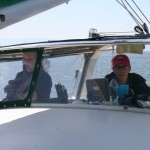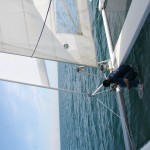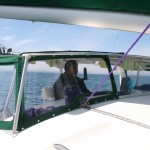When I was five years old, I went to a neighbor’s birthday party. It was a sunny day and she was turning six. All of the neighborhood children were invited and we ate cake in her backyard, surrounded by blooming nasturtiums, fruit trees and cats. Towards the end of the party, her mom brought out a giant bunch of balloons. She gave each one of us a postcard and told us to write a note, asking whoever found it to send a postcard to our address. We each hole-punched our cards and attached them to the strings of our balloons. My friend’s mom counted to three and we all released them.
I remember very clearly the glee in my young mind as I watched the balloons bounce up and drift, carefree and cheerful, pink, blue, green, yellow and purple into the clear sky. I imagined each balloon discovered, still completely inflated somehow, drifting into the arms of another child like me in China, Kenya, France, Argentina or Australia. I imagined receiving the coveted letter, covered in bizarre, wonderful stamps, nothing like the stamps my mom kept in her desk. I waited for it but it never came.

The red balloon floating on the southwestern end of San Juan Island
I hadn’t thought about that day in years until our first time at sea when we rescued a red balloon. It was slightly deflated, drifting listlessly in the dark water. It occurred to me then that it could have very well been the same balloon that I released all of those years ago, except red instead of yellow. When it was lifted clear of the water, I looked at the tangled end of the string, expecting to see a postcard there but no postcard remained and instead, the end of the string was a matted gnarl. We hung the balloon in the cockpit until it had completely deflated and then threw it away. The mystery of balloons didn’t occur to me again until yesterday when we rescued more, a yellow and green pair this time.
It began to occur to me how many balloons must be floating on their own and without permission, released at birthday parties or on New Year’s, slipping from an untidily tied knot on a little girl’s wrist, or wriggling free from fence posts. My thoughts slid, as they do, to consider all of the other things that we humans do to our surroundings, without any consideration for the effects they have.
I don’t mean to imply that balloons have no place in our world, merely that we should all be a bit more mindful of what we do. Last week we had an interesting talk with Russel Barsh, who explained the nature of surfactants and the problems they cause our world. Within our small boat microcosm, we must be continuously aware of our levels of consumption and waste. As we all continue to work on our sustainability projects, we begin to look at our boat time through that frame of reference, rather than a purely research minded one.
I guess the point of my usual rambling is that mindfulness is the first and most difficult step to solving many problems. How many times have we each stormed around in a bad mood, only to realize we were in that mood and feel sheepish and guilty for taking it out on the world? How many mistakes have we each made, simply because we went into situations with ignorance and no realization of it? I’ve come to think that maybe, the very best way we can help ourselves, our world and each other, is by being as conscious as possible, observing and questioning as much as we are able.
So what are you waiting for? Go rescue a balloon!

Hannah rescuing our balloon
We were greeted by rain in Patos’ Active Bay this morning. We ate a hardy breakfast and then headed out into the current. We hung around off the Northeast bit of Patos Island, hoping for more whales. We found no whales, but they did show up near us towards the end of the day. Unfortunately by that time the day was leaving us and our generator was melting down. We kept ourselves well entertained all day though, playing with the echosounder, the fish camera, and plankton. We ended up mooring in Echo Bay and taking the dinghy to shore to stretch our legs and run into CMC friends. Hopefully we’ll reconnect with the whales tomorrow!
Read More
We left FHL at around 14:00 and were heading towards Jones Island when we were alerted by whale watchers on the radio that killer whales were by Sinclair Island and heading north. We continued north, passing Jones and Orcas Islands and cutting in between Sucia and Matia Islands to arrive in Rosario Straight. We first saw the whales on the west side of Matia Island at approximately 17:15. They were traveling towards the south side of Matia Island. We went west along the northern coast of Matia and met up with them again as they traveled north between Sucia and Matia. Male J-1 was easily recognized from the other individuals. We began recording with our hydrophone array at 17:27 and continued for a little more than an hour and a half. Clicks were present throughout the first hour and twenty minutes and through the final twenty minutes there were whistles and calls as well. There were quite a few tail slaps throughout the entire process along with a couple breaches and spyhops. We parted ways from J-pod as we passed along the northern side of Patos Island which caused us to choose Active Cove for moorage for the night. A listening hydrophone was left off of the stern overnight so we would be able to hear if the orcas travel south through Boundry Pass.
Read More
On Thrusday May 7, 2009 I helped out Cindy Hansen, the education curator, at the Whale Museum.  She had a group of 2nd and 3rd grade students come for a killer whale and gray whale workshop!  During the Killer Whale presentation she talked about the biology of a whale, the different types of whales, acoustics, and a id exercise.  I got to talk about my project, the purpose of Beam Reach, and my encounters out at sea.
It was amazing to realize how much these kids know!  They are extremely smart!  I was explaining the behaviors of the transient killer whales the couple of times we saw them the first week.  Then one of the kids raised his hand and said “You don’t need to explain what spy hopping and breaching is, we already know what it is.”  I was like okay, that is really cool!  Then the kids did an exercise trying to identify the Southern Resident killer whales (SRKW)!  It was amazing to see how observant and fast these kids pick up on things.  I was really impressed!  They seem to be very interested in the subject, as well as, my project. Â
Once the discussion was over they did another exercise were they each got a blue card and a sheet with the different SRKWs. Â On the cards, they had to write which whale they got and why their whale is special. It was so cute! Â I enjoyed what each kid had to say. Then they had to split up into pods and find out who their family was. Â It was a great thing to see. Â Along the way, many of the kids and parents asked me many different questions. Â It seemed like the parents asked more weird questions than the kids, I thought it was funny!Â
After that they went upstairs and had a tour of the museum. Â The hit with this group of kids was the read phone booth where you can call whales and listen to their different calls. Â Once they got to the hydrophone area, i got to speak all about hydrophones, like what they do, how we use them, and where they are located. Â I was once again amazed on how much they know and remember. Â These kids even know the whale wise rules! Â They were great! Â While the kids were looking around at the exhibits and taking pictures a lot of the parents came up to me and asked me about college and my studies here at Beam Reach.
Once they were done with the tours, they took a lunch break. After lunch they had a presentation on Gray Whales. Then it was time to put Stinky Bill together.  The kids loved the fact that they were real whale bones.  The kids got split up into four groups and I was in charge of helping the kids find the matching ribs.  My secret to knowing that they were matching was it was labeled! I found it funny that the parents call me the expert.  Then the kids caught on to what i was doing and did the same.  They built this whale with lots of team work.  Why can’t the world work like these kids, with lots of team work? Remember we are all in this together! Â
After they were done they talked about how the gray whale could have died and took votes on it. Â My favorite one was the killer whales rammed the gray whale until its ribs were broken. I was thinking, that kid is totally cool! That is what i wanted the answer to be, but it was hit by a boat. Â
After the program was done the kids did some smart shopping at the gift shop and i helped Cindy pack up Stinky Bill, put away chairs, and clean the floors. I had such a great time and i wish i could do it again!
Read More
Â
We just got back from our first two weeks out at sea on the Gato Verde!  Besides seeing all the marine mammals, sailing is one of my favorite parts!  I have enjoyed the times on the Gato Verde, with the exception of a few times of sea sickness.  I like the adrenaline rush of putting up the main sail.  Then working together to do a proper and efficient tack!  Learning how to sail with Todd is a great experience and i hope to continue it after my adventure with Beam Reach. Â
One of my favorite parts of sailing is at the Helm!  I like the feeling of cruising alone on a nice day out at sea.  I feel so calm and relaxed.  I feel like i am in a different world, then i get a rush of excitement when i have to say “Ready to Tack?” and shift the boat in the proper direction.  Then you can go back to cruising along!  When i am at the Helm i do find it way easier to find a land mark and just follow and every once in a while looking at the instruments to make sure we are safe.  If i have my head wrapped around the instruments to much i just get confused.  So my advice to any future Beamers, just go with the flow and pick a land mark that works for both you and Todd!
Another good part of sailing is the fact that it is fun!  The more you sail, the easier the terminology gets.  You get use to using the terms like Starboard, Port, Bow, Stern, Leech, Luff, Main, Traveler, etc.  Sailing is just one of things that takes practice and a smile! Â
What else i like about sailing is it is a team effort! I strongly believe in working together and in my opinion you need teamwork to sail nice and smooth.  Then once you have lots of experience you can sail by yourself and enjoy the seas through your own eyes.  That is how dreams grow and then come to life right in front of you!Â
Plus another great bonus of sailing, is all the great marine animals you get to see along the way!
Best Wishes,
Peter
PS: Have some fun and safe sailing!
Read More
Mackaye Harbor – Snug Harbor – Jones Island north
5/2/09
The seas were almost barf-inspiring today as we battled the wind northward along the west side of San Juan. We tucked into Mitchell Bay to drop off Val for his haircut appointment (?!) and then continued around the northern tip of the island. All was going well until we got to Spieden Channel, where the current began pushing us backwards. We were forced to turn on our engines in order to make it to the north bay of Jones Island. There we romped around in the rain and finished up the eveining with a double header: Return of the Plankton (dum dum dumm) and The Life Aquatic.
Read More
Snug Harbor – Mackaye Harbor
This morning we had a quick breakfast and collected a gray water sample for Erica and Peter’s surfactant sustainability project from the water used to wash dishes. We spent the morning discussing our progress in becoming comfortable with data analysis methods. We pumped out and filled up with fresh water and then headed towards Discovery Island to try to record the metallic plink that you can hear on the Lime Kiln and OrcaSound hydrophones. Because we didn’t hear the plink we recorded the noise produced by the Gato Verde with various electronics on. We spent the afternoon motor-sailing and working on our individual projects. Hannah and Jason made a lovely dinner of falafel, tzatziki (sp??) and veggie stir fry. Hannah and I attempted a repeat performance of the Team H Caramel Covered Chocolate Spice Cake and we all enjoyed some deck yoga.
Read More

Ahhh, aboard the Gato Verde we seem to have plenty of free time to follow our follies, like experimenting with watercolors and debating/detesting the role of robots in our lives- now a daily occurrence, and the most recent source of my passionate confusion.
If you’re wondering what I mean by robots, look no further, because if you are reading this, then one is literally staring you in the face right now. It has always seemed weird to me that we try to learn more about the natural world by bottling it into numbers, spreadsheets, graphs, and whatever else robots like to eat. The results are in robot-speak, trying to describe with squared off logic the spherical realm.
It’s easy to be an advocate for robots, and it is this propensity for ease that has led us to welcome them into our homes and lives. Despite this, I invite you to think critically about our ever-increasing robot dependency and the balance that could exist between our experiences in the natural world and our obsession with quantification.
Is it enough to thoroughly experience an environment and form a relationship with it in order to foster an understanding of it? Could controlling and testing aspects of an environment reveal, in numbers, more valuable insights than our senses and intuition as part of the natural world provide? I feel that natural history splits the difference here between sheer experience and logical interpretation of the natural world. Unfortunately, the way we have engineered our institutions of learning has led us to a point now that places little or no value on natural historians, in favor of research. Science is loosing the humanity with which it began, as it veers from physical experience in the natural world to number crunching and technological interpretations. It is this dominance of fact over truth that I have found incredibly demoralizing as I continue exploring on my educational path. Could there still be a way to do science that bridges the gap between knowledge and understanding?
Regardless, have no fear. I’m sure when J-Pod returns there will be little to no free time aboard the Gato Verde for painting, debates, and blog-writing, so expect the next ones to be short!
Over and out,
Hannah McGowan
Read More









 Twitter
Twitter LinkedIn
LinkedIn Facebook
Facebook